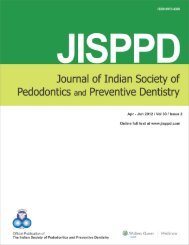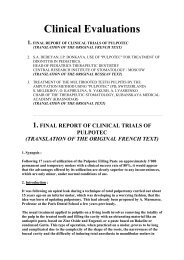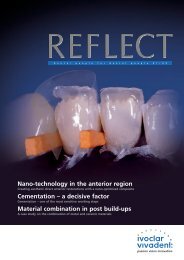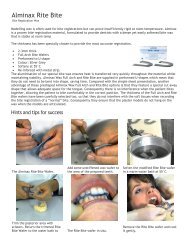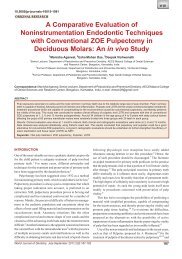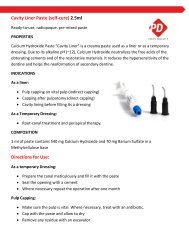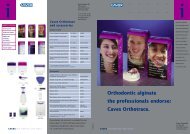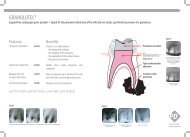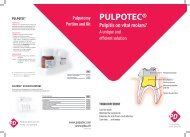temperatureresponsive
View File - universaldental.com.pk
View File - universaldental.com.pk
- No tags were found...
Create successful ePaper yourself
Turn your PDF publications into a flip-book with our unique Google optimized e-Paper software.
lood clots form and so there is no need for<br />
laborious cleaning of the visible treatment area.<br />
The exposure time required for optimum<br />
haemostasis is 2 minutes per application.<br />
However, it has been found, that with low<br />
bleeding levels, this period can be even shorter<br />
due to the very good haemostatic action of this<br />
aluminium chloride gel. However, in the case of<br />
larger areas of gingival bleeding, it should be<br />
noted that, in the case of multiple applications<br />
of the material, an overall exposure time of ten<br />
minutes for the same area of tissue must not be<br />
exceeded in order to avoid the risk of<br />
destructive effects on the marginal periodontal<br />
tissue.<br />
The pronounced haemostatic effect is<br />
accompanied by a clear astringent effect. In<br />
suitable cases, this enables mechanical<br />
retraction of the free gingiva (for example with<br />
cords inserted in the sulcus) to be dispensed with<br />
entirely. Particularly with very delicate marginal<br />
gingival conditions in aesthetically critical regions<br />
of the jaw, it is impossible to overvalue the<br />
advantage of this possibility of dispensing with<br />
the, in some circumstances - despite the greatest<br />
care - excessively traumatic displacement of the<br />
marginal gingiva with respect to the retention of<br />
the gingival cuff in the treatment area. Particularly<br />
with all-ceramic crowns and veneer work in the<br />
region of the upper anterior teeth, the risk that the<br />
post operationem “by a whisker” aesthetically<br />
displeasing atrophied bucco-cervical marginal<br />
gingiva of a tooth represents a permanent threat<br />
on the incorporation of the finished restoration,<br />
even for an experienced, dexterous and cautious<br />
practitioner.<br />
Ah. And, the use of Racegel avoids yet another<br />
problem: the taste which the patients find so<br />
unpleasant. On contact with the tongue and its<br />
further distribution in the oral cavity, this<br />
innovative gel only produces a slightly acid<br />
impression with a hint of bitter fruit and with no<br />
strong unpleasant aftertaste… The best thing<br />
would be to try it for yourself!<br />
In order to “err on the side of caution”, when taking the impression for the production of<br />
the laboratory-made long-term temporaries, before the primary impression during the<br />
correctable impression technique after the action and subsequent spraying of the<br />
described 25% aluminium chloride gel, knitted cords (Ultrapak Retraction Cords,<br />
Ultradent Products) were inserted into the gingival pockets. A perfect, advantageous<br />
combination of a chemically-induced haemostatic-contracting action and mechanical<br />
retraction. All in all, a gentle yet efficient - and above all rapid - method of tissue<br />
management.<br />
The remaining upper anterior teeth of a 67-year-old female patient following the removal<br />
of the splinted single crowns in regions 11 to 13 and 21 to 23. The crowns had to be<br />
removed after the presence of combination restorative dentistry for more than 20 years<br />
due to the irreversible loss of the removable partial prosthesis during the necessary<br />
renewal of the maxillary prosthesis. In the regions of splinted crowns and the locations<br />
of the distal attachments on the canine teeth, the marginal gingiva had pronounced<br />
inflammation. To enable systematic periodontal treatment to be performed before the<br />
final prosthetic care, it is necessary to protect the anterior teeth with “periodontalfriendly”<br />
and “oral-hygiene promoting” long-term temporaries. To this end, initial gentle<br />
repreparation of the teeth is necessary.<br />
The remaining mild intracrevicular seeping haemorrhage was arrested by another<br />
selective application of the gel directly into the marginal sulcus regions. (Note the stable<br />
gel layer in the cervical region of the stump of 21 after application from the thin needle).<br />
Here, once again, we can see benefits of the thermogelling properties of the material<br />
which permit precise application into the desired areas and immediately thereafter<br />
effect stable adherence to the wetted solid and soft tissue. The exposure time until<br />
repeat spraying was once again two minutes.<br />
7



